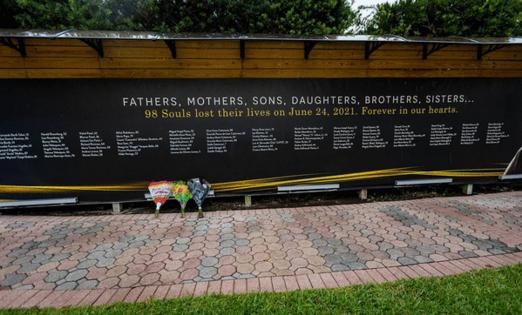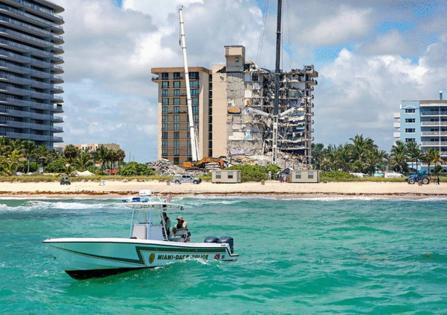Federal report on Surfside collapse won't be released until 2026. What's taking so long?
Published in News & Features
MIAMI — Delays in the federal probe into what caused the deadly Champlain Towers South condo collapse in 2021 mean a draft report on the findings is now expected in 2026, a year later than previously estimated.
In a Sept. 12 update, an investigative team with the National Institute of Standards and Technology said a variety of challenges related to testing, obtaining documents and interviewing witnesses have slowed down the process.
“Unfortunately, we have faced technical and programmatic delays that have caused us to adjust our timeline,” said lead investigator Judith Mitrani-Reiser.
In a presentation last week, investigators pointed to several factors causing the delays.
A key member of the geotechnical team, which is focused on below-ground conditions, departed. Interviews with witnesses and other stakeholders have taken more time than anticipated, due in part to a pause around this year’s collapse anniversary, out of respect for the families, and struggles in obtaining local government records.
Testing of concrete samples and critical connections in the building has also been challenging, investigators said. The process involves the recreation of materials to resemble key slab-column connections at the pool deck and lobby levels of Champlain Towers South, and then simulating corrosion of the reinforcing steel bars and testing them to understand their strength.
More than $33 million has been spent on the investigation so far, officials said.
Pablo Langesfeld, whose daughter and son-in-law died in the collapse, said the delays were disappointing.
“We don’t need more hypotheses. We need solid and concrete answers,” Langesfeld said during the meeting. “We need answers now.”
Two years ago, investigators said they were on track to release their draft report in 2025. That was still the case in an update this past March.
But Mitrani-Reiser said last week that the team’s technical work likely won’t be completed until May 2025, with a draft report anticipated in the spring of 2026. Members of the public will be allowed to comment on the draft before a final report is released.
By then, it will have been five years since the collapse that killed 98 people in Surfside on June 24, 2021, shaking the small beach town and raising existential questions about building safety for high-rise dwellers across the country.
Other investigations by NIST, which has examined the causes of catastrophic building failures including the World Trade Center, have taken between two-and-a-half and six years to complete.
Glenn Bell, who is co-leading the Champlain Towers investigation with Mitrani-Reiser, called it “one of the most complex building failure investigations ever undertaken.”
The agency assembled a team of dozens of engineers and other experts tasked with conducting an exhaustive review of the collapse by testing materials from the collapse site, creating computer models to simulate the event and, after determining why the building fell, making recommendations on how to prevent similar catastrophes.
“We will continue to work just as hard as we can to ensure that we are being thorough and that our results are sound,” Bell said, “so that we can provide accurate and complete answers to what caused this tragedy and to develop appropriate recommendations that will make other buildings safer.”
The team has already tested more than 1,000 concrete and rebar samples taken from the collapse site, officials said. The materials are being stored at two warehouses in undisclosed locations.
NIST officials said last week that they have begun returning those samples to the Miami-Dade Police Department, as they are considered evidence in a death investigation by the department that remains open.
In prior public updates, investigators have said there is “strong evidence” that the Champlain Towers collapse began in the pool deck of the 12-story, L-shaped Champlain Towers South building, though they had not yet ruled out an initial failure point “in some part of the tower” that could have led to the collapse of the deck.
A Miami Herald investigation found that the pool deck collapsed several minutes before half of the tower fell. In consultation with structural engineers, the Herald identified major weaknesses in the structure and other problems that compounded in the weeks before the collapse. Those included areas where the pool deck appeared to be sagging dangerously, cracking a nearby planter.
The conclusions by NIST will have implications for millions of high-rise dwellers around the world, as the agency is likely to recommend changes to building codes and construction practices.
Legislation passed at the county and state levels since the collapse has already had substantial impacts on condo living in South Florida. Inspection requirements have been tightened, and new rules are forcing condo associations to maintain reserves for repairs.
Champlain Towers South was undergoing a critical 40-year review before it fell. After an engineering firm highlighted “major structural damage” and a “major error” in the design of the pool deck in 2018, repairs were postponed amid disputes over costs as unit owners faced a $15 million bill and massive individual assessments.
©2024 Miami Herald. Visit at miamiherald.com. Distributed by Tribune Content Agency, LLC.










Comments